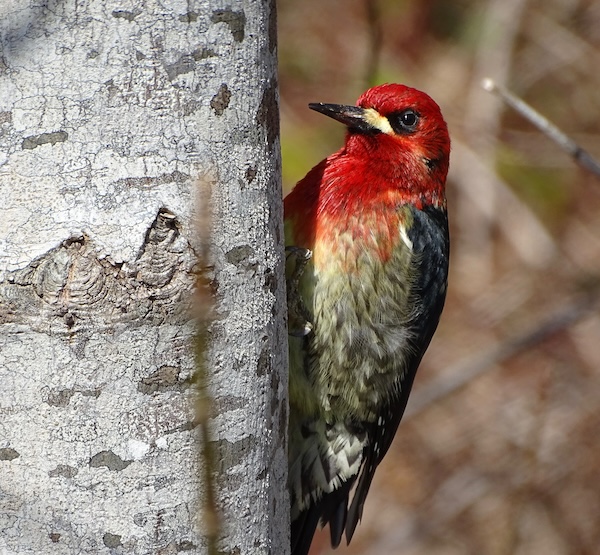Bird Count Results and Report
— by George Sirk
Top photo – Red-breasted Sapsucker, George Sirk
Sunday, December 17, was indeed a lovely day to conduct our Audubon’s Christmas Bird Count. It was calm with some early fog but turned sunny and mild at 5 to 7 C. A total of 28 participants participated, and another 10 or so reported from their feeders at home. The “count day” was bracketed on each side by three days of observation defined as “Count Week” – CW.
Counting birds for a whole week gives us a better understanding of all the birds that are here in the Cortes’s environs.
Rarities are added to the count when a photograph or detailed field notes are provided. Our island was divided roughly into three main areas: Whaletown, Mansons Landing, and Squirrel Cove. We divided into groups and searched each zone from 9 AM until 3 PM. Group leaders met at the museum at 3 PM and tabulated the results.
I want to acknowledge and thank the Museum, especially Gina Trzesicka, for all the organizing during the weeks leading up to the count day, the tabulation of the data, and subsequent submission to the Audubon Society and Birds Canada.

I analyzed the data and made the following observations:
Sixty-seven species and 2873 individuals were observed. Four further species were observed during the CW. The average # of species recorded in 22 years is around 70. The total # of individuals was about average as well.
The most common seabird is the Surf Scoter with 1411 – the highest total since 2001 with 1440. The second place went to the Bufflehead with 133, the highest since 2005 (136). White-winged Scoter came in at 56 – most since 2005 (134). The Greater Scaup had the highest # ever with 65, and the Harlequin had 77, the most in five years. Common Loon came in at 70 – the highest # ever. Red-necked Grebes also set a record at 60. Horned Grebes, 60, and one Eared Grebe were noted in Seaford. No Western Grebes were recorded on the count week, but approximately 100–200 were spotted off Read Island two weeks after the count. This bird was missed during our CBC count as the species prefers deep water and is hard to observe from shore. The Great Blue Heron came in at 15, an 8-year high (16). In the 22 years of observation, the number 15 was seen only once, in 2004. It’s great to see this wonderful bird make a comeback!

“Hundreds” of ducks were observed in the distance at Sutil Point, but this area was hard to reach due to the high tides and the need for more observers to scout the area. The reef off Marina Island was not censused; it would also add hundreds of seabirds to the tally. Shark Spit was visited by a kayak from Whaletown. One explanation for the high numbers of seabirds observed is possibly because of the excellent conditions: the sea was glass calm with hardly any wind, and the sun helped as well; around 2100 seabirds were identified! A bird of note is the Semipalmated Plover in Whaletown and four of Killdeer in Smelt Bay. Greater Yellowlegs came in at three, again in Whaletown. And it should be noted that two weeks later, 14 Yellowlegs were seen in Whaletown Bay! This species has been moving north over the years, possibly due to the mild weather, as ice in the bay would make it hard for them to feed.
Gulls were low in numbers.
Twenty-two Bald Eagles and one Red-tailed Hawk. Sharp-shinned & Cooper’s Hawk were also spotted, and it was great to get two Pygmy Owls and a Barred Owl. Pygmies are making a slow comeback.
Some forest bird numbers were down. No Red-breasted Sapsuckers were spotted on the day of the count but were seen during the CW. They are secretive. Other woodpeckers were about average. Fourteen of Anna’s Hummingbirds came in from bird feeders, an average. All the finches/sparrows were down in numbers. The cyclic Red Crossbill (4) and Pine Siskin (1) are at a low point. Juncos dropped from 717 last year to 129. Most of the finch and sparrow records come in from feeders.
Overall, it was a great day for the count. The fair weather certainly helps birders to spot the birds.

The most exciting sighting of the day – for sure – was a mom and calf Humpback Whale – between Cortes and Twin Islands… The whales are supposed to be on their way to Baja California or Hawaii!
I want to thank all the volunteers and the Cortes Island Museum for their dedication to this snapshot of Cortes Island’s birds! We would also like to thank all the private property owners who allowed us to count birds on their grounds.
See results in table formats:
2023 CBC – Field List (by area, pdf)
CBC All Years List, 2021-2023 (pdf)
— by George Sirk



